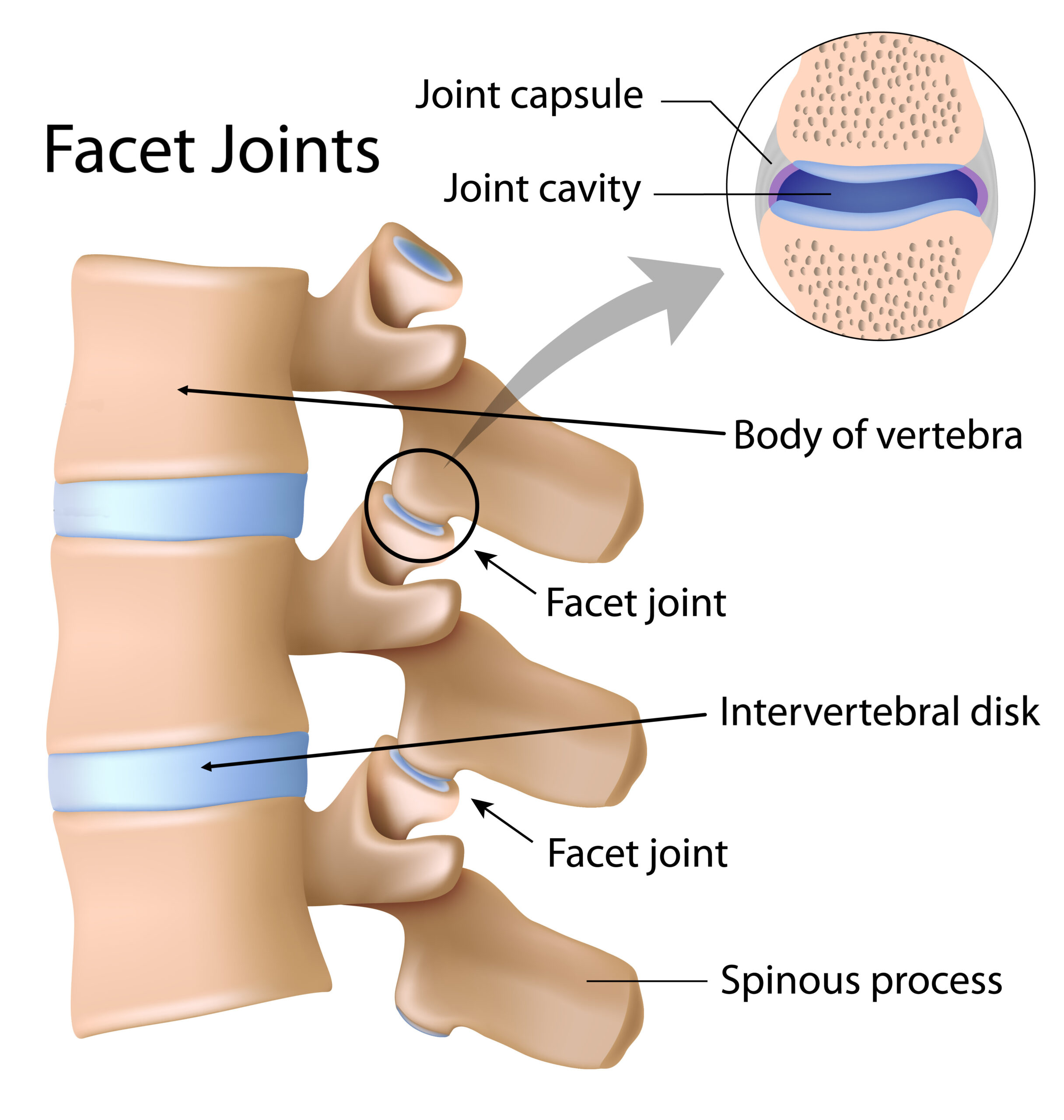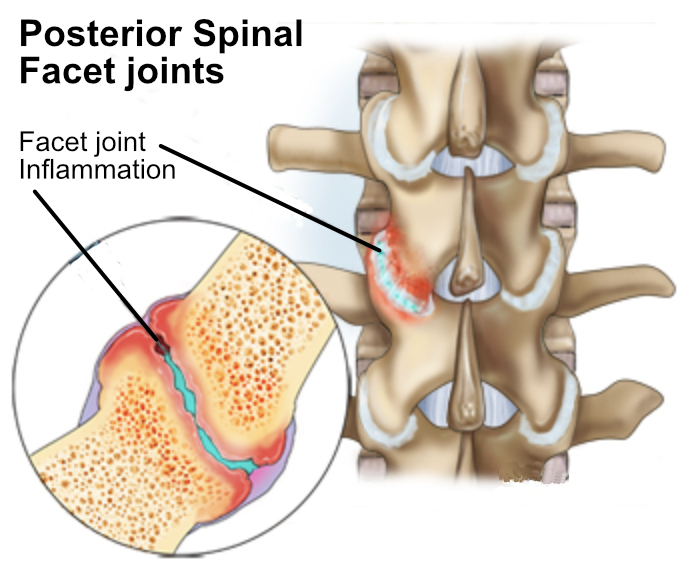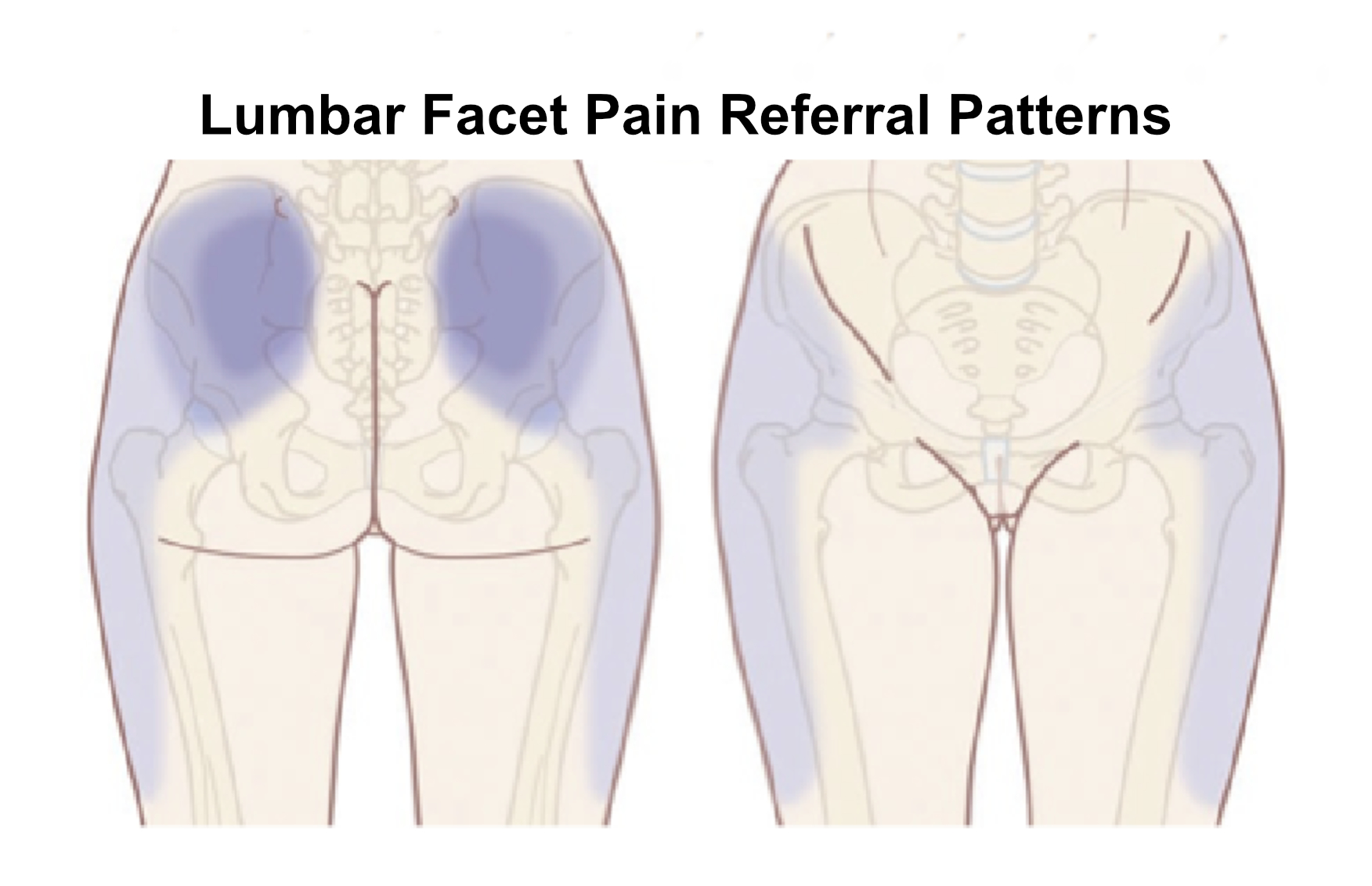Facet joints are small joints in the spine between each pair of vertebrae. Pain from these posterior joints can occur at any level of the spine. It is most common at the lower two lumbar spine (at levels L4-L5 or L5-S1), but also frequently occurs in the neck and mid back.
Research shows that Chiropractic joint manipulation with exercises are very effective treatments of facet pain. Chiropractors are trained extensively to be specific and find the exact facet joints that are injured by feeling with their hands. Facet joints are the main source of the popping sounds when the spine is manipulated. Because of their rich supply of nerves, facet joints can cause intense pain when irritated or locked.
In the young and healthy, weight bearing loads and compression are primarily taken by the vertebral body and disc. As we age, however, increased load is slowly transferred to the facet joints, which leads to strain and degeneration.
When we place increased stress on the facet joints they are far more likely to be irritated, which can lead to pain or wear and tear arthritis. Excessive extending of the spine backwards in spinal extension or hyperlordosis especially increases facet wear. This can be either in an accident, like a whiplash to the neck with high force, or with a low force over a prolonged time, such as sitting or standing with bad habits, when we may not feel the pain until the strain has built to a point that it starts to become symptomatic.
Anatomy of the Lumbar Facet Joints


Facets are pairs of joints at the back of the spine and have synovial joint properties, with hyaline cartilage. They provide stability to the spine and protection to the spinal cord yet allow an extraordinary amount of movement. They are part of the three-joint complex at each vertebral level. They allow more flexion or forward-bending, with small amounts of rotation and lateral flexion and extension. With the high compressive forces on the lumbar spine they can easily become inflamed. Small capsular tears can cause pain, synovitis and swelling, along with protective spasm of the surrounding muscles. Fibrous adhesions can build up around the joints; this causes degeneration with osteophyte formation over time.
Repetitive small injuries (micro trauma) are the most common cause of facet joint irritation. For example, repetitive back extension, especially on movements with the arms above the head, or in sports with strong hyperextensions of the lumbar spine.
Lumbosacral Facet Joints – a Common Source of Low Back Pain
Facet joints have been suggested as the most common source of low back pain (about 15-45% of patients with chronic LBP). They are commonly overlooked as a source of chronic low back pain; an absence of a clear clinical picture makes it difficult to confirm their origin of the pain. Doctors rarely perform physical examinations to diagnose facet joint pain, and anaesthetic injection blocks which can confirm facet joints as the cause are not widely available. Some studies show that more than 80% of back pain may be attributed to the facet joints.

Cause of Facet Joint Pain
Both men and women are affected, commonly aged 40-70yrs, with increasing age wear and tear.
Spinal injury, trauma, obesity, heavy lifting and overuse of the flexible joints cause facet pain.
Commonly it’s a mixture of poor posture and sitting, with small repetitive strains or micro-trauma from wrong habitual movements.
Meniscoid facet joint entrapment
There is a sometimes a fold in the joint capsule projecting inwards, which can get trapped. Chiropractic manipulation which focuses specifically on releasing the injured facet can be very effective. Read here for the full article on Meniscoid or Synovial syndrome.
Nerve irritation with facet joints
Overlying the facet joints are small sensory nerves. These can be irritated and cause pain. There are several symptoms that indicate a person’s pain is coming from the facet joints. Swelling surrounding the facet joints causes pain and can irritate the nerve roots similarly to sciatic disc herniation with neurological symptoms such as a numbness and pins and needles.
Signs and Symptoms of Facet Joint Pain
- Dull, difuse back pain, usually on the side of the injury
- Local point tenderness and stiffness in the surrounding muscles
- Bending backwards, extension or hyperextension movements painful or stiff
- The spine can lock to one side in Antalgia or torticollis (wry neck)
- Pain in pelvis back when lifting a straight or extended leg
- When coming up from bending over, the spine can be stiff or weak with patients needing to use their hands to climb up their legs in order to straighten up.
Chiropractic tests to diagnose facet joint pain
From a medical viewpoint, there is no gold standard for identifying facet joint pain, other than facet injections. X-rays are helpful, but are a static picture. Chiropractors find that with sensitivity and practice, it is possible to feel the injury with their hands (palpation) and springing or pushing on the injured face joint. With motion palpation, we can feel where there are exact blockages of movement, especially in lateral flexion and rotation, which can produce pain and stiffness at the affected joint. Extension, lateral flexion and rotation orthopaedic tests of the spine (Kemp’s test) can also elicit pain.
| Increased facet joint pain | Decreased facet joint pain |
|---|---|
| Movements in general, but more pain in extension leaning back than forward. | Walking |
| Walking for too long | Resting the back lying with knees bent up |
| Prolonged standing or sitting | Medication |
| Stiff in the morning and after inactivity and sudden movements i.e. getting up from sitting | Leaning forward supported, especially standing, or resting on a supermarket trolley with weight on forearms |
| Sitting flexed over, like in the car | Rest |
| Side-bending towards affected side | Side-bending towards healthy side |
| Returning from bending down (flexed position) | Varying activity, changing positions |
| Coughing and/or sneezing | Sitting |
Referred pain from facet joints

From the lower spine into the buttock, groin or down the back of the thigh, only above the knee.
From the neck into the neck, shoulder and arm,
From the midback (dorsal or thoracic spine) around the ribs.
Read this PT360 article for further information regarding referred pain.
Chiropractic Treatment for Facet Joint Pains
Spinal manipulation alongside exercise are two of the most effective treatments for both acute and chronic facet joint pain. Manipulation releases both the facet joints and the deep muscle spasms close to the facet joint. Alongside Chiropractic treatment, other treatments and exercises are indicated:
- In the acute phase, an ice pack can be helpful to decrease the inflammation.
- Resting the back – some lying down with your knees raised to help reduce the pressure on the facet joints.
- Varying your activity while avoiding movements that are painful.
Chronic long-term strains are more involved. If wear and tear – degeneration – is present, with disc height reduction, the facet joints can take more strain and load, increasing the stress and possibility of injury. Recurrent episodes of facet joint pain can indicate ‘functional instability’ with more scar tissue or fibrous adhesions. In some cases with severe degeneration, the condition may need more long-term management.
Change in lifestyle is usually required, with less sitting, more variation of activities such as using a sit-stand desk, losing weight, and less driving.
Correct exercise long-term will be extremely important for facet joint stability. Equally important is advice on how to move and sit, for which Alexander Technique can be excellent.
Cervical Facet Joint Injury
Cervical or neck facet joint injury can cause neck pain and headaches, and also cause pain radiating into the arms and upper spine. The cervical facet joints have a rich supply of overlying nerves that innervate the deep neck muscles, which can cause pain. Spasm at the C2-C3 joint is supplied by the third occipital nerve, a cause of headaches.
Causes of cervical facet joint injury
The cervical facet joint is susceptible to trauma caused by a fast movement strain of the head backwards in extension, side bending, and rotation, such as in an acceleration-deceleration injuries like a whiplash injury in an RTA (Road Traffic Accident). The joint capsule or the meniscoid body can be trapped by the facet joint.
Another common complaint from clients is that they “just woke up with the pain” after holding the head in an awkward position for an extended period: sleeping in an uncomfortable position, lying on the sofa watching TV or using a laptop or tablet. The head can be in a side-bent and rotated position, possibly with a “locked” antalgic neck and unilateral neck pain.
Examination of neck facet strain
Because of the impingement and muscle guarding, movement is painful and clients experience decreased movement with contralateral side bending and rotation. There is sharp tenderness on touch or palpation of the affected facet joint.
Chiropractic treatment for cervical or neck facet sprain
Ice is usually correct, especially if there is intense pain or swelling. In the acute phase, the objective is to reduce the muscle spasm to help restore movement and decrease pain:
- Deep massage or trigger point treatment with some gentle traction can release the muscular spasm.
- Various different contract-relax release exercises of the cervical muscles can be very beneficial
- Chiropractic adjustment to the cervical spine is also very effective when the severe muscle spasm has decreased and the patient can tolerate the movement. With experience, it is possible to tell when the manipulation can be performed.
- Clients often experience fairly quick improvement in the acute cases, particularly when there has been no major traumatic onset.
- With severe injuries such as car accidents, Chiropractic treatment is best given as soon as possible. This can help tremendously to speed recovery and prevent long-term postural changes, bad adaptive movement patterns and chronic muscle spasm.
Medical Diagnosis and Treatment of Facet Pain
Facet joint injection diagnosis
Facet joint injections can be performed in the cervical, thoracic or lumbar regions, and are considered by some in the medical profession as the gold standard in diagnostic evaluation.
In 1976 research, saline solution injections to healthy facet joints created radiating pain into the buttocks and posterior thigh. Following studies showed this pain could be relieved by intra-articular injections, demonstrating the facet joints are a clear cause of back pain. Saline solution injections into the cervical facet joints can cause pain in the arms or upper back and can ‘map’ specific referral pain patterns.
Medical treatments for facet joint injuries
- Physiotherapy will usually involve strengthening exercise, which can sometimes be helpful, but can also aggravate the condition if done excessively or incorrectly.
- The Chiropractic approach I use is quite different and more hands-on.
- Sometimes, acupuncture is used.
- Non-steroidal anti-inflammatory (NSAIDs) drugs are commonly given, but are shown to reduce healing so should be used minimally, if at all.
- Steroid joint injections to the facet joint.
- Anaesthetic nerve to block pain.
- Surgery: If all other conservative treatments fail, operations that fuse the joints may be an option.
Overall, a variety of treatment approaches is helpful.
Imaging diagnosis of lumbar facet pain
- X-rays don’t diagnose facet pain, only advanced degeneration or osteoarthritis and other spine conditions, like scoliosis or spondylolisthesis.
- Computed tomography (CT) scan.
- Magnetic resonance imaging (MRI) scan.
- Diagnostic blocks – where medicine is injected into the facet joint nerves near the joint and a 50% reduction in pain indicates the facet joint is involved.
References
https://www.physio-pedia.com/Lumbar_Facet_Syndrome
https://www.mayfieldclinic.com/pe-facet.htm
https://www.sciencedirect.com/topics/medicine-and-dentistry/facet-joint
Todd R. Hooks PT, SCS, ATC, MOMT, MTC, CSCS, FAAOMPT, in Physical Rehabilitation of the Injured Athlete (Fourth Edition), 2012